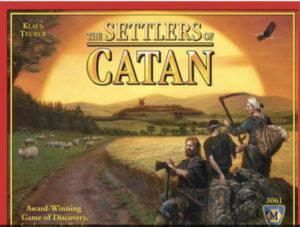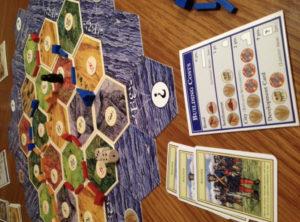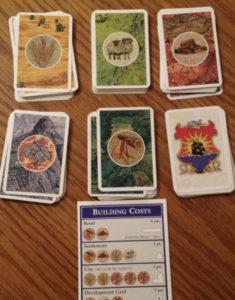
Game: Settlers of Catan
Game Developers: Klaus Teuber
Device Played: Board Game
Target Audience:
- Age Range: 10+
- Anyone who likes strategy and war games
Formal Elements of Game:
Players: Multiplayer (3 – 6 players)
Objective: Through their initial settlements, players can collect resources. Players can use the resources to build roads to be able to expand into other new settlements and cities. A settlement gives players 1 victory point, and a city gives player 2 victory points. The first player to reach 10 victory points wins the game!

Outcomes: If you are the first player to reach 10 victory points, then you win the game. If not, you lose.
Types of Fun:
- Discovery: Discovery is the main type of fun of Settlers of Catan. In fact, every time one plays, the island and its ports look different (Hexagonal tiles with the resources are randomized at the start of every game). Thus, both novice and veteran players have new island and in turn a new strategy to explore every time! The main part of discovery, however, comes when players build roads to make settlements. The ability to explore and build settlements on unsettled territory is vital to the fun of the game.
- Fantasy: While fantasy is not the main type of fun, the Settlers of Catan does take place in a make-believe world. The preface of the game is that there is a group of settlers trying to tame the wolds on the island of Catan. Instead of money, the settlers (players) use combinations of resources: grain, wool, ore, brick, and timber to purchase development cards or build road, settlements, and cities. While there is no stereotypical fantasy such as dragons or fairies, I would still argue that the preface of the game is still very much make believe. Despite fantasy not being the main type of fun, the preface given provides important reasoning that helps make the objective of the game clearer. If anything, the fantasy aspect of the game is key in making the onboarding process a little more digestible.

Moments of success or epic fails:
- Epic Success: Due to the random mix of different board (islands) for virtually every game, I never get bored no matter how many times I play the game!
- Epic Fail: In my opinion, the onboarding process for novice players is quite long and boring. The first couple of days that someone tried to get me to play, I could not get into it because they seemed to be too many rules to learn. Ultimately, I am glad that I took the time to learn, but I found the rules to incredibly confusing at first.
Things I would Change: Game Balance
- I love Settlers of Catan; however, the game is not balanced. To determine the location of initial settlements, players simply roll a dice and whoever has the highest number gets to pick first. Thus, if a player has bad luck rolling, then they get walled off by other players from the start and make coming back hard. While giving players different starting resources and positions is inevitable to make the game interesting, Settlers of Catanshould have more avenues to gain resources to deter a singular lucky player from making a monopoly of an important resource. This will also allow the players with bad initial luck a chance to catch up. I love that the game is asymmetric, but it is not fun to play a game in which you know you have no chance of winning from the beginning.
Balance Between Game Objects:
- While I think some “objects” of the game have a better cost/benefit ratio, I believe Settlers of Catan does a good job of balancing game objects. All the resources are useful and necessary, as a different combination of all resources are used to build roads, settlements, and cities.
Settlers of Catan utilizes transitive and intransitive relationships for balancing game objects.
- Transitive Relationship: Roads, Cities, Settlements, and Development Cards each cost a certain number of resources. For instance, to build a road, a player must pay one Brick Card and one Lumber card.
- Intransitive Relationship: For Settlers of Catan, I would argue that there is typically a ‘dominant’ resource or resources at a given state of time. However, what the dominant resource is at the time depends on the randomness of the board game and the last couple dice rolls. For instance, if any players only have settlements at sheep farms with rolls of 4 or 9 and both those 4 or 9 have not been rolled in a while, then the resource sheep becomes a rarity among players and thus vied after. For the next couple rounds, sheep becomes a “dominant” resource and players are often willing to trade a lot of resources for one sheep. As the dominant/most valuable resource changes every couple turns, I would argue that none of the objects are dominant, as it depends on the luck of the roll! A player needs to have access to all resources to be able to be successful in the game, making the game well balanced.



